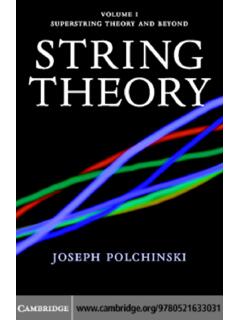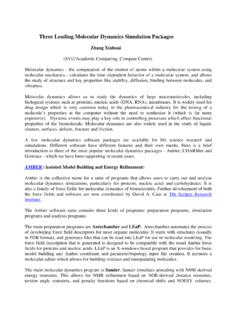Transcription of Quantum Theory and Relativity - Arthur Jaffe
1 Quantum Theory and RelativityArthur Jaffe harvard UniversityCambridge, MA 02138, 1, 2007 Dedicated to George MackeyAbstractElsewhere I describe some personal encounters with George Mackey [31]. Those discussionsoften returned to a common set of questions: Does physics suggest a way to combine Quantum Theory , Relativity , and interaction? To what extent can one formulate such Quantum physics as mathematics? What is the present status of Quantum field Theory ? What new mathematics emerges? What new insight does one apparently require to make further progress?We touch on these topics here, not only outlining some of the technical issues, but also attempt-ing to addresswhyone believes in their IntroductionTwo major themes dominated twentieth century physics: Quantum theoryandrelativity.
2 These twofundamental principles provide the cornerstones upon which one might build the understanding ofmodern physics. And today after one century of elaboration of the original discoveries by Poincar e,Einstein, Bohr, Schr odinger, Heisenberg, Dirac and many others one still dreams of describingthe forces of nature within such an arena. Yet we do not know the answer to the basic question: Are Quantum Theory , Relativity , and interaction mathematically compatible?Even if one restricts Relativity to special Relativity , we do not know the answer to this question aboutour four-dimensional world much less about other higher-dimensional worlds considered by stringtheorists!Should Quantum Theory with Relativity not qualify as logic? Physics suggests that a natural wayto combine Quantum Theory , special Relativity , and interaction is through a non-linear Quantum progress on this problem has been made over the past forty years.
3 This includes showingthat theories exist in space-times of dimension two and three. Building this new mathematicalframework and finding these examples has become known as the subject ofconstructive quantumfield review some of these developments here. But before addressing this question further, we setdown a couple of ground rules. Although one cannot derive these starting points from basic firstprinciples, we attempt to explain the road we take. I am grateful to the of the Z urich for hospitality while I wrote this paper, and to Barbara Drauschkefor proof-reading the let us ask about the domain of validity for the laws of physics. In searching forthese laws, can one be content in finding laws that are effective within a limited domain of nature such as laws that describe atoms and molecules, or laws that pertain to strong interactions andelectrodynamics, but that touch on neither gravity nor weak interactions?
4 Or can one only besatisfied when one can formulate a Theory that encompasses all of physics?For example, special Relativity and the notion of Minkowski space-time revolutionized the notionof classical physics. But one might argue that space-time itself cannot remain strictly Minkowski-like at extremely high scales of energy or in the neighborhood of a black hole; so should one onlystudy theories where space-time can have a more general character possibly curved, or possiblywith a Quantum nature, or both? Can one justify, from the point of view of physics, the study ofspecial Relativity in great detail? How much human thought and effort should one invest in givinga mathematical foundation to an incomplete picture of nature?Our position on this question is that past success in understanding physics has always beenpartial and within limited domains.
5 But within these domains one has pursued theories to theirlogical conclusion. Insight into broad arenas of physics followed studies that ranged from Newton slaws of planetary motion, to extremal principles in the laws of mechanics and optics, Maxwell slaws of classical electromagnetism, probabilistic laws of Brownian motion, statistical foundations ofthermodynamics and phase transitions, and non-relativistic Quantum Theory to mention just a each of these examples is specific to a certain domain of relevance. A big part of the successand the appeal of these theories rests with their elegance and simplicity, and another appeal is thedepth of understanding they provide within each realm of physics. These theories not onlymodelparts of nature; but in addition they yieldlasting beaconson the frontiers of knowledge markersto which one returns time and time course one constantly strives to widen the scope of our understanding.
6 As we acquire moreknowledge, we expand our horizons, always requiring that new points of view incorporate previoussuccesses and insights. Some physicists have proposed very ambitious plans; at one limit, stringtheorists try to find a Theory of everything. Laudable though this goal may be, the formulationof all-encompassing principles has remained this as background, we state our first ground rule: it is valid to address the partial goal,are Quantum Theory , special Relativity and interaction compatible? one accepts an intermediate and partial goal in the description of nature, then oneconfronts a related question: why require that a partial Theory have a firm foundation in logic?In other words, why provide a valid mathematical basis for a partial set of physical laws?
7 Is itnot better to focus effort on discovering new principles that describe a wider spectrum of naturalphenomena? If one accepts that view, then one might only attempt to clarify the logical foundationsof physics after achieving a much better, if still putative understanding of response to that proposal is another appeal to history. Each of the classical areas ofphysics mentioned under scope qualifies as a subfield of mathematics. For centuries, the traditionin physics has been to describe natural phenomena by mathematics. Eugene Wigner marveledon the relevance of mathematics in his famous essay [60], On the Unreasonable Effectiveness ofMathematics in the Natural Sciences. Intuition can go a long way. But by endowing physics witha mathematical foundation, one also bestows physical laws with longevity.
8 For mathematical ideascan be understood and conveyed more easily than conjectures, both from person to person, and alsofrom generation to recent years we have witnessed enormous progress in another direction of transferring ideasfrom physics to mathematics: to play on Wigner s title, concepts from physics have had an un-reasonable effectiveness in providing insight to formulate mathematical conjectures! The resultinginfusion of new perspectives has truly blossomed into a mathematical revolution, which has beensufficiently robust to touch almost every mathematical frontier. I have written and talked on thisQuantum Theory and Relativity3latter topic extensively elsewhere, but this is not the central theme that we investigate , we simply formulate the second ground rule:physics should be a subfield of mathematics!
9 In other words, one should add the adjectivemathematicallyto the wordcompatiblein groundrule one. George Mackey often advocated this point of view in our conversations, and most everymathematician would find this an appealing thought. Being mathematics does not limit the use ofinsight or stop one making unjustifiable approximations to gain insight into a particular problem the only requirement is to be clear about what parts of physics are mathematics and which partsare real question is whether this goal is realistic. No matter how laudable it may be to strivefor a mathematical Theory of physics, can one expect to achieve it? This brings us inevitably to thefundamental question posed at the outset. Understanding some self-contained, but complete nuggetin this sea of knowledge can produce work of lasting historical value a mathematical work of approach the question from the point of view of Quantum field Theory .
10 In spite oftremendous qualitative progress mentioned above in understanding space-time dimensions less thanfour, the space-time in which we live still remains a mystery. So we first point out some facts thatmotivate hope for the success of this quest, namely the success of Quantum electrodynamics. Thenwe explain some approaches to giving a mathematical foundation to Quantum field Theory . But wethen return to explain the currently-widespread belief that a mathematical treatment of quantumelectrodynamics may well be impossible!If this were true, it would certainly represent a departure from traditional thinking that onecan study the electromagnetic forces by themselves. But today physicists believe that one shouldincorporate the equations of four-dimensional electrodynamics into the four-dimensional quantumYang-Mills equations, or elaborate them into the standard model.

